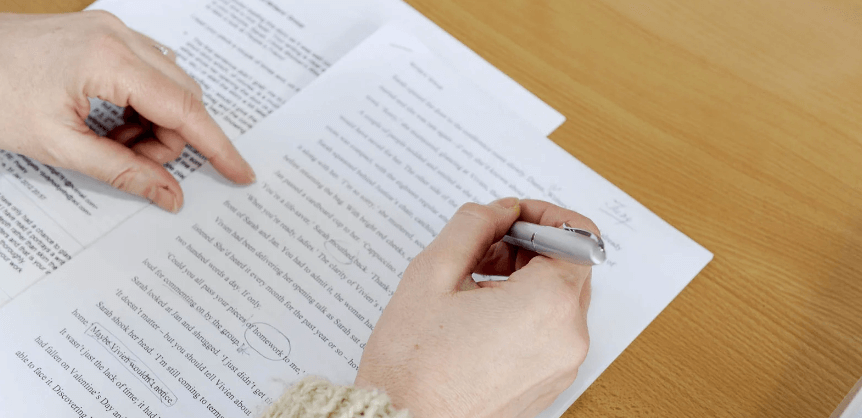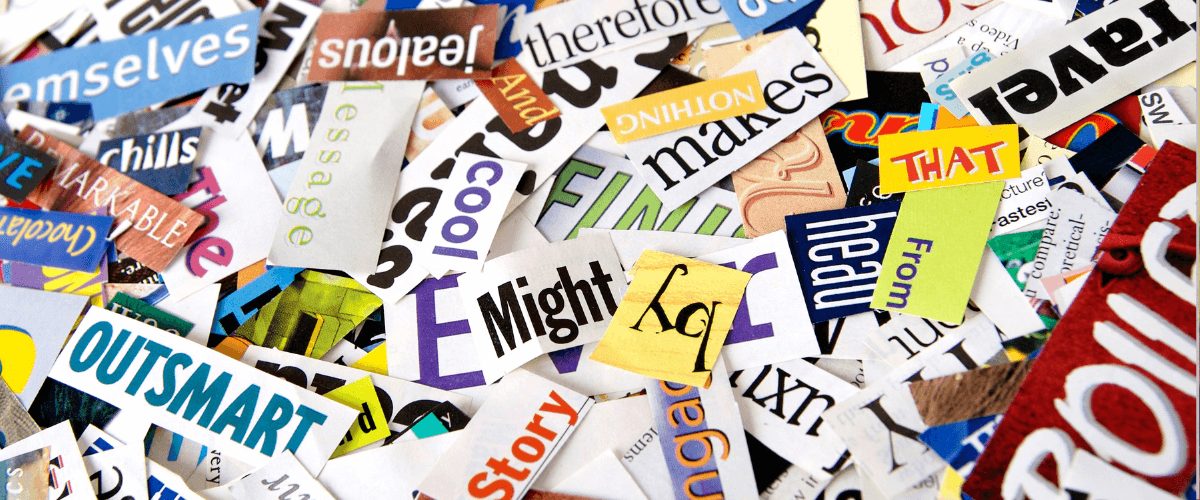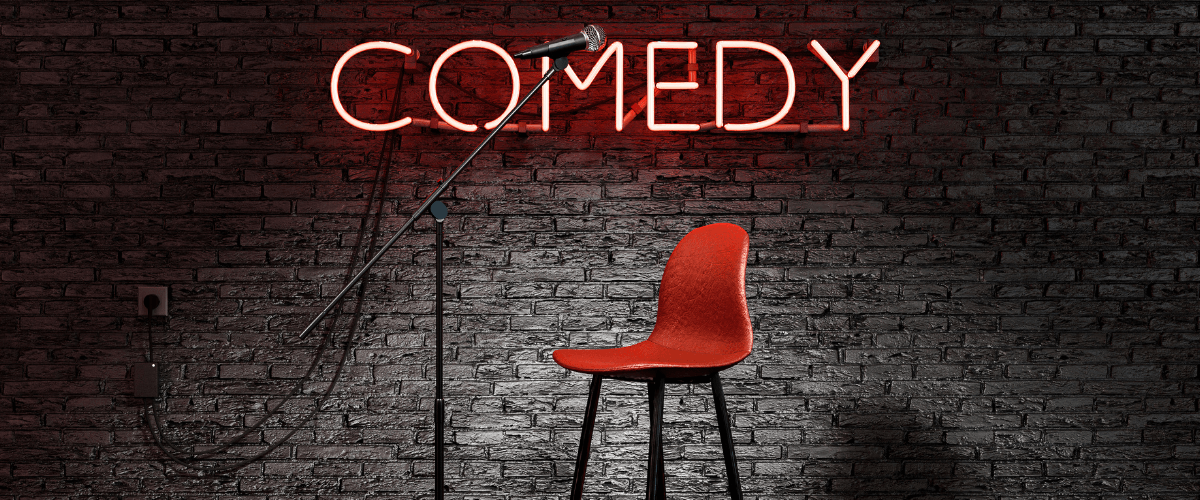COMEDY COURSE HOME | COMEDY BASICS | COMEDY WRITING | COMEDY PERFORMANCE | THE COMEDY BUSINESS | PRO COMEDIAN TIPS | HISTORY OF COMEDY | OTHER RESOURCES & MISC BITS

A lot of people don’t understand that stand-up comedy is written. They have the idea that comedians simply go up on stage and make it all up as they go along, because they’re naturally funny people. That’s part of being a great stand-up, the ability to deliver your material in a natural, conversational style, so that it really feels like you’re just chatting to the audience instead of reciting a script.
But if you want to try stand-up comedy, then you’re going to have to write some material. Go to enough open mic nights and you’ll see newbies trying to make it up on the spot; their friends tell them they’re funny and they should do comedy, so they get it into their heads that they can simply go on stage without a plan and just be their usual hilarious self.
They learn quickly that making a room full of strangers laugh at a stand-up comedy night is very different to making a handful of friends laugh in the bar.
This is the first big difference between writing stand-up comedy and just being funny in daily life. Your friends, family, and colleagues already know a lot about you, so when you crack a joke they have all the background context about your life and personality that helps them to understand why what you said is funny. That room full of strangers waiting for you to entertain them, they don’t know a single thing about you, so you’ve got a lot more work to do.

To Write Stand-up Comedy, You Have to Actually Write
This might sound obvious, but not everybody gets it. Unless you’re a super-rare one in a million talent, you’re not going to be able to just walk out onto stage and deliver killer material off-the-cuff. You’re going to have to write some jokes.
Most stand-up comedians know the value of getting as much stage time as possible, but writing is just as important. Writing is like performing; the more you do it, the better you get at it. So write as much as you can, as often as you can and accept that, just like regularly bombing on stage, writing material that turns out to be complete junk is all part of the process.
Try to spend some time writing every day. You can brain dump ideas for new material, or spend some time working on improving older material.
All writers know that most of what they put on the page isn’t great at first, and it’s going to take a lot of editing and rewriting before some of it’s any good – but you need to take that first step of putting something, anything, on a blank page. That’s the hardest step, but it’s what gives you the raw material you can shape into killer bits.
A page full of bad ideas might have one glimmer of gold that can, with work, be turned into a great piece of material. But a blank page is worthless. Your first and most important task is to fill that blank page with some ideas, even if they’re all bad.

Fine, But How do I Actually Write Funny Material?
The first thing you need to know about writing stand-up comedy is that there’s no single blueprint for success. If you’ve watched many successful stand-up comics doing their thing, you should have noticed just how many styles and approaches there are, and they all work in different ways.
The kind of material that works for you will depend a lot on your personality, your look, your stage-presence, your delivery, and a lot of other things. For example, simply walking onto stage and saying “Hello” to the audience isn’t really funny, but try to picture a big, weird looking guy, with an expressive, wild-eyed look on his face, crazy hair, and he stumbles onto the stage looking lost and confused, he slowly looks around the audience as though he’s wondering who they all are and why they’re looking at him. Then, with an enthusiastic, friendly voice and a strange accent that nobody can quite place, he says “Hello.”
I’ve seen that exact situation, and it got a big laugh. Just from the word “Hello.”
Why did it work? Probably because of the contrast between the way the guy looked (weird, confused, out of place) and the way he introduced himself (endearing, friendly, a kind of innocent enthusiasm). There’s a little tension as he stumbles on stage and the audience wonder what the hell is happening, and then that tension is burst when he introduces himself with a single word.
This building of tension, then bursting it, is a well known element of writing stand-up comedy, and we’ll get into it more later. Also, a large part of this particular situation is that the guy’s voice was kind of unexpected – it didn’t fit with his appearance, and that surprising contrast can also get laughs.
But what works for one act won’t necessarily work for another – everybody’s different. For example, there was a guy I used to see regularly at open mics who tried the same thing; he’d walk slowly up to the mic and then say “hello” in a high-pitched squeaky voice and then give a little chuckle as though he’d just said the funniest thing in the world. The audience never laughed.
Why didn’t it work for him?
It was too forced, too fake. His whole black-leather-jacket look was like somebody desperately trying to emulate an old-school edgy alternative comedian. The squeaky voice he used to introduce himself was obviously put-on – he dropped it as soon as he started the rest of his set.
Somebody had obviously told this guy on a stand-up comedy course that the contrast between the way you look and the way you sound can be funny, so he tried to force it, and it didn’t work for him because there was zero authenticity.
What’s going to work for you? The lesson here is to try to write material that’s authentic to you, because people can tell when you’re faking it, and that kills the funny.
You need a lot of self-awareness, to know how other people perceive you (both in terms of your appearance and your personality) which will help you understand what kind of material you should write.
There’s no point a middle-aged married dad, trying to write stand-up comedy material about Tinder dates, house-sharing, or clubbing – the audience can clearly see that’s not the world they inhabit, so it’s going to be hard to make the audience come along with you on those topics. Equally, young, fresh faced acts trying to put on embittered, world-weary stage personas, doesn’t work so well when you’re barely out of school and the world hasn’t had time to grind you down yet.
The Rules of Writing Stand-up Comedy
Writing comedy is an art, not a science. It’s not the same as writing computer software, where you can always achieve a specific objective by following a set of rules. Material sometimes works for strange, magical reasons that nobody understands, and sometimes it doesn’t work even when it looks good on paper.
All that said, there are common ideas that can help you write stand-up comedy. We can call them “rules” if you like, but the best comedians break these rules all the time. Still, it’s a good starting point, and once you understand the rules, writing stand-up material will be a lot easier, even if you choose to completely disregard them.
Setup – Punchline – Tag
Most jokes follow a simple format:
- Setup – this is where you explain the background story, or context of your joke, what does the audience need to understand for it to make sense.
- Punchline – this is the funny part of the joke, the thing you expect the audience to laugh at.
- Tag – this is an optional extra punchline, that builds on the previous one and gets another laugh.
Let’s look at a simple example of this structure in Romesh Ranganathan’s 2016 Live at the Apollo set – specifically the opening bit during the first 60 seconds
Setup: He wishes the audience a merry Christmas, explains that he is Hindu, and wonders how he managed to get such a prestigious gig…
Punchline: “I just wanna thank diversity quotas.”
Tag: “You’re getting two for one with me, because I’m Asian and I’ve got a lazy eye. You get ethnicity and I’ve got a disability.”
Not all stand-up comedy follows this format, but if you watch enough comedians doing their thing you’ll see that a lot of their jokes do, whether they’re pun-slingers, story-tellers or observational acts, they frequently use that exact structure.
The difference between somebody who can make their friends laugh, and somebody who can make an audience laugh lies in understanding how to write setups and punchlines.
When you make your friends laugh, you’re probably going straight to the punchline, because the setup has already been established through your relationship – you have a shared history, you know the same people, the same stories, and in-jokes. So when they laugh at something you say, it’s because they already have enough information to know why it’s funny.
Think of a time you said something that made your friends laugh. What background information did they have that made them understand why your comment was funny? Can you use that background information to create a short, punchy setup that can easily be understood by complete strangers, so that if you said the exact same thing to them, they’d laugh too?
But why is a punchline funny? How does a punchline turn a setup from a story into a joke? Again, there are lots of different reasons, but one of the most commonly used tools of writing stand-up comedy material is the broken assumption.
Broken Assumption
When you are explaining your setup to an audience, they will make all kinds of assumptions about the scenario you’re describing – they have to, we all do it every day, because the alternative is that we’d have to explain everything in an exhausting amount of detail to remove all possible ambiguity.
Comedy lies in shattering those assumptions.
The oldest example of this is “I just flew in tonight…”
Most people assume the comedian flew on an airline to the city where they are performing. But the assumption is broken by the punchline “…and boy are my arms tired.”
You’ll see new stand-up comedians often using punchlines like:
- “…and then I got off the bus.”
- “…and that’s how I got banned from the library.”
Where the setup involves them doing something that would be perfectly fine in the privacy of their own home, but not in a public place. The assumption is that the scenario described in the setup was taking place in private, but that’s broken when the punchline reveals it happened in a public place.
Another common example is a setup that involves an awkward encounter with a weird or rude person, who is assumed to be a stranger, and the punchline is usually something like:
- “So I said go home dad, you’re drunk.”
- “That’s the last time I invite my mum.”
These are simple examples, and if you go to enough open mic nights you’ll see them hundreds of times.
This joke format is also called a “pull-back and reveal” which simply means that you use the punchline to reveal some missing information that makes the situation funny. It’s a very common joke structure used to write stand-up comedy. An example of the pull-back and reveal is this old joke (attributed to the American comedian, Jack Handey) “[setup] I’d like to die peacefully in my sleep like my grandfather did, [punchline] not screaming in terror like his passengers.”
The pull-back and reveal is that his grandfather was driving a car when he died – and it’s also an example of broken assumption because when you hear that somebody died peacefully in their sleep, the assumption is that they were in bed at the time.
So, the broken assumption and the pull-back and reveal are very closely related. A successful punchline gives the audience the missing information they need to understand why your story is funny, and it usually works because the missing information breaks an assumption they made during your setup.
A great example of broken assumption is from Jim Jeffries famous bit on gun control in his 2014 special, Bare.
In this bit he’s talking about gun control and explains that there is only one argument for gun ownership. Most people in the audience are likely to assume he’s going to provide a reasonable, serious reason for owning a gun, and then dismantle that argument, but instead he delivers the punchline “Fuck off, I like guns!”
You think you know where he’s going with the bit, but then he subverts your expectation with a petty, childish argument for wanting to own a gun.
If you can master this skill, of getting people to come along with you on a topic, and then completely throwing their expectations you’ll be able to write some great stand-up comedy material.
Another aspect of what’s happening in that set is the use of tension. A lot of comedy is based around the idea of creating tension with the audience, by saying something controversial or talking about a divisive topic, and then bursting that tension with a funny, unexpected punchline.
Comedy audiences are there to have a good time, that’s the point. So when a comedian starts to talk about something that isn’t usually considered a fun topic, the audience gets worried that things are going to be weird and uncomfortable – tension is created in the room. But then the comedian bursts that tension with a punchline that makes everything OK again, and reassure the audience that they are going to have a good time.
This is a tricky skill to master. A lot of new comics try to do it by being edgy and talking about highly controversial topics, but if their punchlines aren’t good enough then the tension doesn’t get burst and that can ruin the rest of the set.
When you first start to write stand-up comedy, be aware of the fact that a lot of new acts try to be edgy and dangerous, but they often fail at it because it takes time to build the skills needed to pull off that style of material.
The Rule of Threes
In stand-up comedy writing, the Rule of Threes is simply that grouping three things together can be an effective way to write a joke. You list two things that make sense together, and then the third thing breaks the pattern in a funny way – you can think of it as the simplest form of the setup-punchline format: the first two things are the setup, and the third is the punchline.
Here’s an example of the Rule of Threes: “Have you ever worked in an office? They’re weird places. An office is a big room full of desks, computers, and arseholes.”
In the setup we’re talking about offices, and we start listing the things that you typically find in an office, desks, computers… and next the audience is expecting to hear something like phones, or photocopiers, but the assumption is broken by the punchline: arseholes, which most office-workers can relate to.
The rule of threes works so well when you’re writing stand-up comedy material because it’s the quickest and most efficient way to establish a pattern for the audience, and then to break that pattern in a surprising way. Again, it’s about broken assumptions –they think they know what to expect from the next thing you’re going to say, but you go off in a different direction and subvert their expectations.
Word Economy
In this joke example we used earlier, did you notice anything missing?
“I’d like to die peacefully in my sleep like my grandfather did, not screaming in terror like his passengers.”
The punchline doesn’t state whether the grandfather was driving a car, or a bus, or flying a passenger jet – because it doesn’t need to. It could have been any of those things and the joke still works, so it’s left to the audience to fill in the blanks with whatever they imagine is the funniest.
This is a good example of another important rule of stand-up comedy writing: word economy.
While being a good story-teller is important, and adding colour and context to a joke might work well for some comedians, it’s also good to learn how to make your jokes as tight and efficient as possible.
When you write a joke that works, think about what parts you can remove without losing any of the impact. What is the absolute minimum you need to say in order for the setup to make sense and the punchline to deliver the laughs?
This is important, especially for a new open-mic level stand-up comedian, because you really want to get as many laughs as possible in the five-minute spots you’ll be doing. More than anything else, people will rate you based on how many laughs you can get from the audience in a short space of time.
Sometimes it won’t work, you might try to cut a joke down to the bare minimum, but for some reason a part of the setup that you didn’t think was critical ends up being the thing that makes it work, so you’ll need to try out different versions of the same joke to figure out just how much you can cut without killing the bit.
Funniest Word at the End
Another thing you might have noticed about the grandfather joke is that the very final word of the punchline is the payoff; passengers. It’s that single word which makes the whole joke make sense; right up until that word is spoken the joke isn’t clear.
Wherever possible you should put the funniest word, or phrase, right at the very end of your punchline because you want the audience to start laughing at the point where you stop speaking. Comedians call it “stepping on your laughs” when you’re still trying to talk while the audience is laughing.
The whole point of stand-up comedy is to make people laugh, so if they’re laughing you need to shut up and just enjoy the glory. They won’t be able to hear what you’re saying anyway.
If you find that audiences are regularly laughing before you finish getting the joke out, you might need to re-write the material. Figure out what’s making them laugh before the end of the joke and make that your first punchline. Whatever part of the joke you wrote after that punchline can be used as a tag to follow up once the laugh has died down.
You will often find that audiences don’t react to your material in the way you expect. A lot of the time they won’t laugh at any of it, but they’ll sometimes laugh at parts of your setups that you never intended to be funny.
Call-backs – Instant In-Jokes
A call-back is simply a joke that makes a reference to another joke you made earlier in your set. Call-backs often work really well, because they can feel like an in-joke between you and the audience; you’re making a joke about something they remember laughing at earlier.
This isn’t the same as a tag, where you immediately follow the punchline with an extra punchline. A call-back happens later in the set, while you’re talking about a different topic, but find a way to relate it to your earlier material. If you can use a call-back as your closing bit (which should always be one of your very best bits, regardless of whether it’s a call-back or not) you’ll often get a strong reaction from the audience.
Start Strong, Finish Stronger
When you’re working out the order in which to tell your jokes, there’s a simple rule that most stand-up comedians use; start with your second best joke, finish with your best joke.
The reasoning for this is that you always want to finish your set on a strong laugh, so the audience feels like they’ve had a great time, so that’s where you put your very best joke. You start with your second best joke so that the audience very quickly has confidence in your ability, and once you’ve made them laugh for the first time it will be easier for them to laugh at the rest of your material.
If you’ve got new material that you’re still unsure of, make sure it’s always sandwiched between two strong bits.
Writing Stand-up Comedy on Stage
While it’s important to write stand-up comedy material as much as you can, there’s absolutely no substitute for stage-time. You simply won’t know if your material works until you try it out on a real audience.
They’ll laugh in unexpected places, or not at all, sometimes they’ll clap, sometimes they’ll groan, sometimes they’ll yell out heckles which are actually pretty funny so you can steal them and add them to the material as if you wrote them yourself.
A written joke is a first draft, but the editing takes place on stage. And this is why it’s really important to record your sets. You don’t need to film them, just the audio will do, and you can use a recorder app on your phone or buy a cheap voice-recorder device, whatever works for you.
Listen to the recording soon after the show – maybe not right away, if you can’t handle that, but certainly the next day – and make note of where people laugh, any places where you messed up, or improvised something good, anything that gives you useful information about how to improve the material.
A lot of people find that they don’t remember much about what happened during their set, other than a vague sense of whether it went well or not. Listen back to the recordings and you’ll discover a gold-mine of detail about what actually happened during the show.
Be Real, Be Authentic to Yourself, Be Original
There’s a lot to take in here, but most of it will start to come naturally if you write and perform stand-up comedy regularly. Here are a few closing thoughts to help you on your way:
Be Real – stand-up comedy material doesn’t need to be true, but it needs to be plausible. You’re trying to get the audience to buy into the story or the joke, so make it easy for them to do that. Maybe your style is absurdism, and that’s fine, but if you need the audience to believe the setup to your joke is a real scenario, then you have to make it sound believable.
Be Authentic to Yourself – this is different to being real. What I mean by being authentic to yourself is the audience needs to believe that you believe in what you’re saying – the material you perform needs to match the persona you present to them. People can spot fakers a mile away.
Be Original – give the audience something they haven’t seen before, and they’ll love you for it. There are a lot of stand-up comedians out there, and many of them are churning out very similar material. If you write something and it feels like it’s been done before, throw it away and try again.

Learn more about Comedy Writing here
COMEDY WRITING









